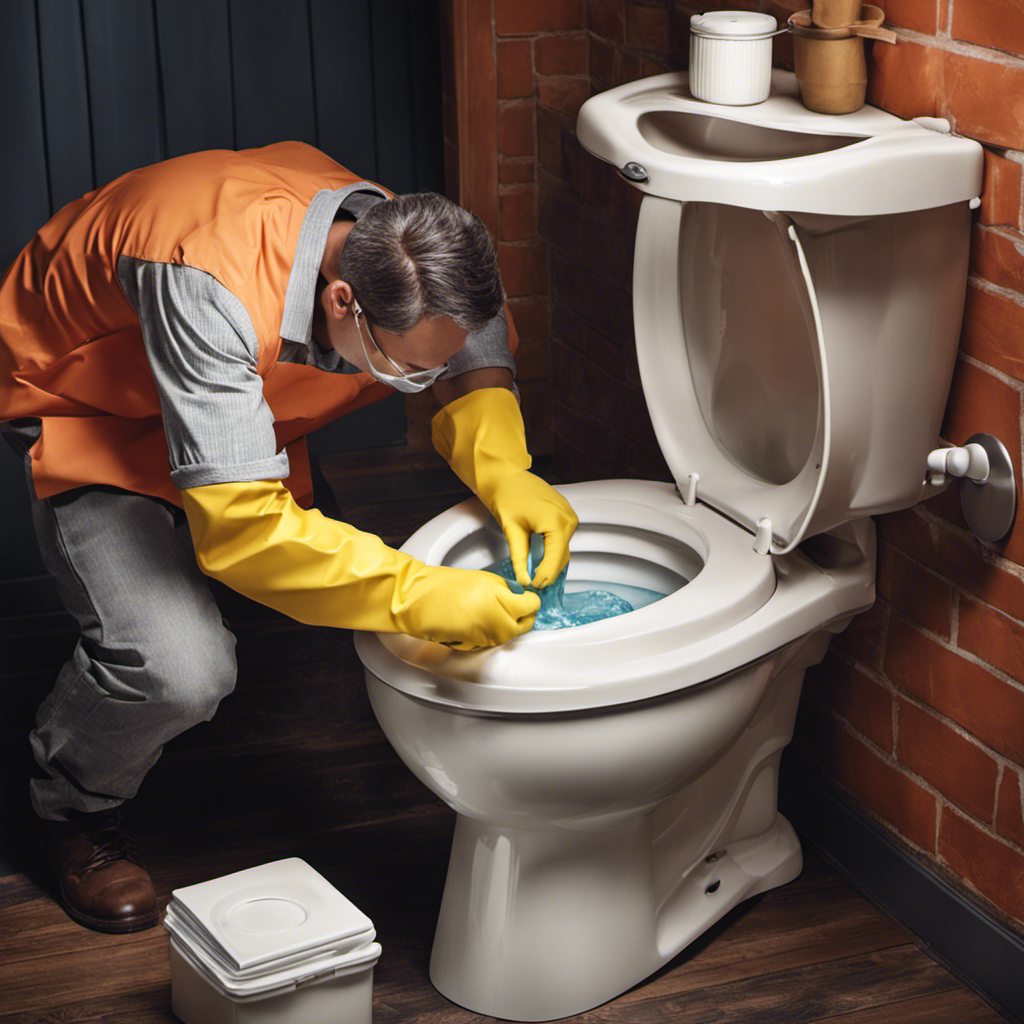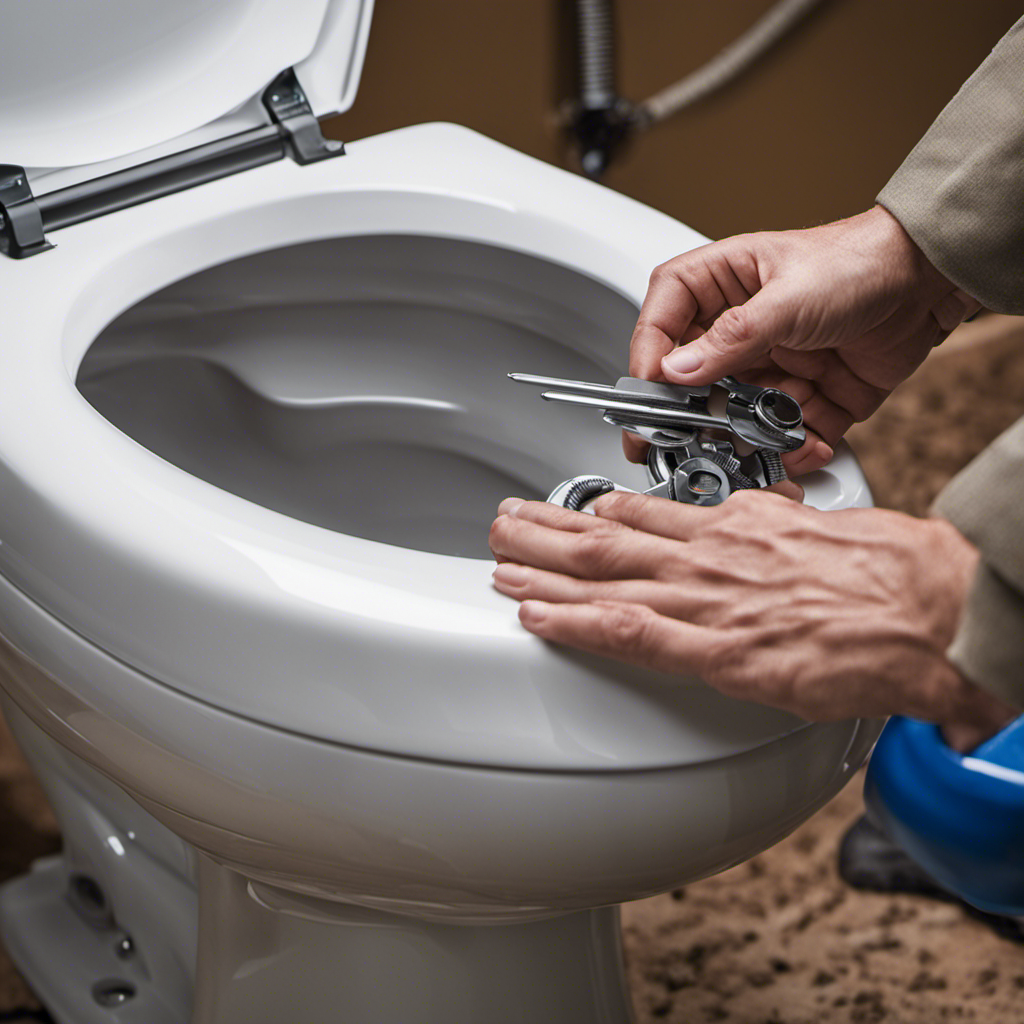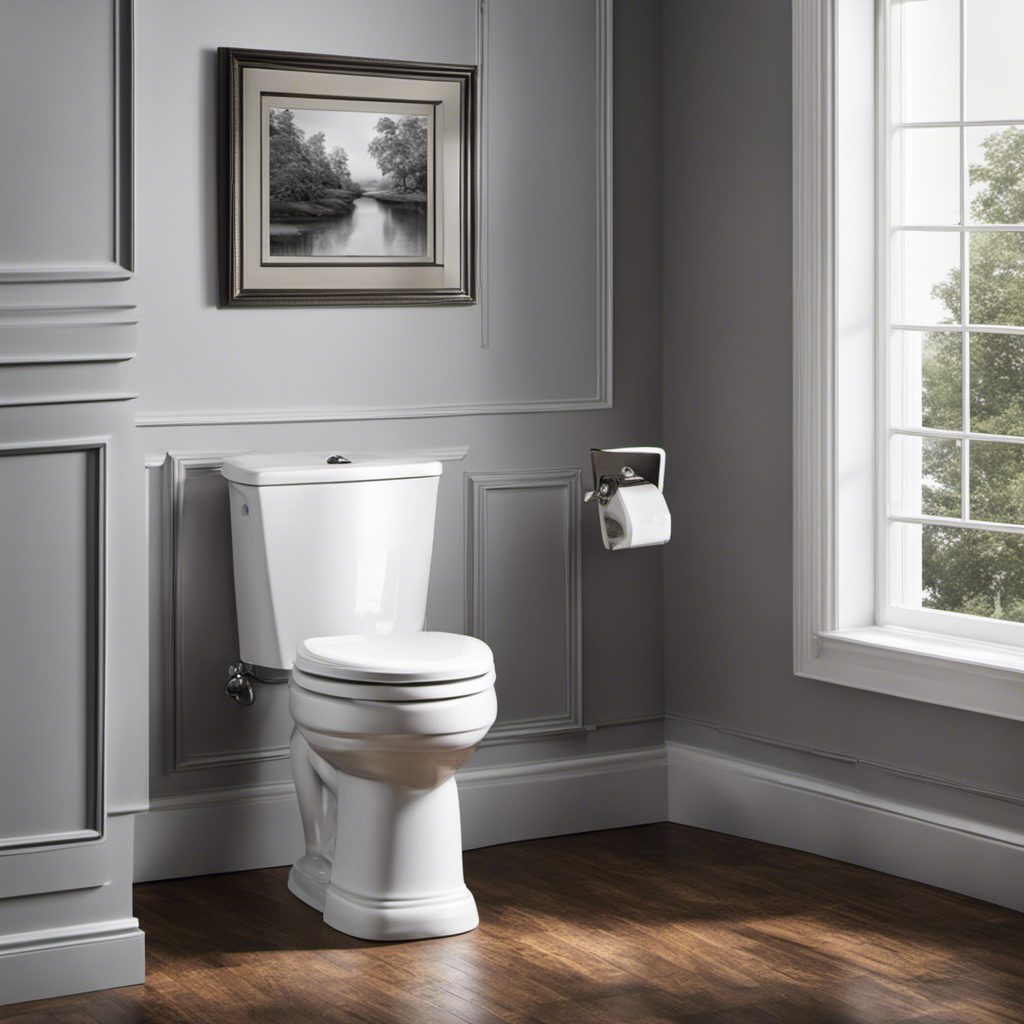Hey there, folks! Ever found yourself in a sticky situation with a leaky toilet? Don’t fret, because I’ve got just the solution for you.
In this article, I’m going to walk you through the step-by-step process of turning off toilet water. From understanding the shut-off valve to locating it and actually shutting off the water supply, I’ve got all the nitty-gritty details covered.
So grab your tool belt and let’s get to work!
Key Takeaways
- The shut-off valve controls the flow of water to the toilet.
- Proper shut-off valve maintenance is crucial to ensure it functions properly.
- Locate and turn off the shut-off valve behind the toilet to stop the water flow.
- Use a water shut-off key or alternative tools like pliers or a wrench if a shut-off key is not available.
Understanding the Shut-off Valve
To turn off the toilet water, you’ll need to locate and operate the shut-off valve. The shut-off valve is usually located behind the toilet bowl or on the wall near the base of the toilet. It’s a small lever or wheel that controls the flow of water to the toilet.
Proper shut off valve maintenance is crucial to ensure it functions properly. Over time, shut-off valves can become stiff or develop leaks. If you notice any issues with your shut-off valve, troubleshooting is necessary.
First, check if the valve is fully open or closed. If it’s stuck, you can try lubricating it with some WD-40. If you have a leaky shut-off valve, you may need to replace the valve or use a wrench to tighten any loose connections.
Locating the Shut-off Valve
First, you’ll need to find the shut-off valve for the toilet’s water supply. This valve is crucial for valve maintenance and can be used to shut off the water supply during emergencies. Here are some steps to help you locate it:
- Look for the water supply line behind the toilet. It is usually a flexible hose that connects to the bottom of the tank.
- Follow the supply line towards the wall until you find a valve. This valve is typically a round or oval-shaped handle.
- Once you’ve located the valve, turn it clockwise to shut off the water flow to the toilet.
- To ensure that the water is completely shut off, flush the toilet and check if it stops refilling.
Turning off the Water Supply
You’ll need to locate the shut-off valve for the toilet’s water supply before proceeding. Once you have found the shut-off valve, it’s time to turn off the water supply.
Start by turning the valve clockwise until it is fully closed. This will stop the flow of water to the toilet, preventing any further leaks or damage. It’s important to do this step before attempting any repairs or finding replacement parts, as working on a live water supply can be dangerous.
Using a Water Shut-off Key
When it comes to shutting off the water supply, one of the most efficient and convenient methods is using a water shut-off key. This handy tool allows you to quickly and easily turn off the water at the main valve, preventing any further damage or leaks.
The benefits of using a shut-off key include its ease of use, durability, and compatibility with different types of valves.
However, if a shut-off key is not available, there are alternative methods such as using pliers or a wrench to turn off the water supply.
Benefits of Shut-Off Key
One of the benefits of using a shut-off key is that it allows you to quickly and easily turn off the water supply to your toilet. This can be particularly helpful in emergency situations or when you need to make repairs.
There are different types of shut-off keys available, including T-shaped keys and square keys, depending on the design of your shut-off valve. These keys are designed to fit into the shut-off valve and provide leverage for turning it off. Some shut-off keys also have a built-in handle or grip, making it easier to turn off the water quickly.
Alternative Shut-Off Methods
If you’re looking for alternatives to shut-off keys, consider using a shut-off valve with a lever handle for a simpler and more convenient method. These valves are commonly used in emergency situations or when temporary shut off methods are needed.
The lever handle allows for quick and easy operation, making it ideal for situations where time is of the essence. To use the shut-off valve with a lever handle, simply turn the lever clockwise to shut off the water flow. This method is especially useful in emergency situations such as a burst pipe or a leaking toilet.
However, it’s important to note that shutting off the water at the main valve is still necessary to completely stop the water flow and prevent any further damage.
Shutting off the Water at the Main Valve
When it comes to shutting off the water at the main valve, two important factors to consider are the valve’s location and accessibility.
The valve should be easily accessible and located in a place where it can be easily reached in case of emergencies or maintenance needs.
Furthermore, understanding the importance of shutting off the water at the main valve is crucial as it can prevent further damage in the event of a plumbing emergency or allow for necessary repairs to be made safely.
Valve Location and Accessibility
Locating and accessing the valve to turn off the toilet water can sometimes be a challenge. It’s important to know where the valve is located in case of emergencies or when you need to perform maintenance on your toilet. Here are a few common accessibility challenges and shut off valve problems you might encounter:
- Hidden or hard-to-reach valve locations
- Rust or corrosion making the valve difficult to turn
- Valve handles that are stuck or stripped
- Lack of proper labeling or identification
When faced with these challenges, it’s crucial to address them promptly to ensure the valve can be easily accessed when needed. Proper maintenance and regular inspections can help prevent common shut off valve problems.
Now that we understand the accessibility challenges and common problems, let’s delve into the importance of shutting off the toilet water.
Importance of Shutting off
To prevent potential damage and emergencies, it’s crucial for you to understand the importance of shutting off the water supply to your toilet. Regular maintenance is key to keeping your toilet functioning properly and preventing any water damage risks.
By shutting off the water supply, you can prevent water from continuously flowing into the toilet tank and potentially overflowing. This is especially important in case of a leak or a malfunctioning toilet that could cause significant water damage to your bathroom and home.
It’s recommended to shut off the water supply whenever you’re away for an extended period or if you’re experiencing any issues with your toilet. By taking this simple step, you can save yourself from costly repairs and potential water damage headaches.
Shutting off the Water at the Toilet Tank
You can easily shut off the water at the toilet tank by turning the shut-off valve clockwise. This is an essential skill to have, especially during emergencies or when you need to do repairs.
Here are some tips to help you shut off the water at the toilet tank effectively:
-
Using pliers to shut off: If the shut-off valve is difficult to turn by hand, you can use a pair of pliers to get a better grip and apply more force without damaging the valve.
-
Shutting off in emergencies: When faced with a toilet overflow or a leak, shutting off the water at the toilet tank is the first step to prevent further damage. It is crucial to act quickly and shut off the water to minimize any potential water damage.
-
Turning the shut-off valve clockwise: To shut off the water, locate the shut-off valve, which is usually located near the base of the toilet. Turn the valve clockwise until it is fully closed. This will stop the water flow to the toilet.
Additional Tips for Turning off Toilet Water
Now that we know how to shut off the water at the toilet tank, let’s explore some additional tips for turning off toilet water.
Proper toilet water maintenance is crucial to prevent leaks and water damage. One important tip is to locate the emergency water shut off valve for your entire house. This valve is usually located near the water meter or where the main water line enters your home. Familiarize yourself with its location and ensure it is easily accessible in case of emergencies.
Another helpful tip is to periodically check for any leaks or drips around the toilet base or water supply line. If you notice any, promptly address them to prevent further damage.
Frequently Asked Questions
Can I Use Any Tool to Turn off the Water Supply to My Toilet?
I can use a wrench or pliers to turn off the water supply to my toilet. It’s important to locate the shut-off valve, usually located near the base of the toilet, and turn it clockwise to stop the water flow.
How Often Should I Turn off the Water Supply to My Toilet?
It’s important to know how often to replace toilet parts and be aware of common issues that can occur with the water supply. Regular maintenance can prevent costly repairs down the line.
Is It Necessary to Turn off the Water Supply to the Toilet if I’m Just Fixing a Minor Issue?
Yes, it is necessary to turn off the toilet water supply when fixing minor issues. This ensures that water doesn’t flow while you work, preventing any potential leaks or accidents.
What Should I Do if I Can’t Locate the Shut-Off Valve for My Toilet?
If I can’t locate the shut-off valve for my toilet, there are alternative methods to shut off the water. One option is to turn off the main water supply to the house. Another option is to use a shut-off tool specifically designed for toilets. To prevent toilet water from overflowing, I can adjust the water level in the tank or fix any issues with the fill valve or flapper.
Will Turning off the Water Supply to the Toilet Affect the Water Supply to the Rest of My House?
Turning off the water supply to the toilet won’t affect the water supply to the rest of the house. However, not turning it off during repairs can lead to water leaks and potential damage. Alternative methods include shutting off the main water valve.
Conclusion
In conclusion, turning off the toilet water is a simple yet crucial task that can save us from potential disasters.
Just like how we have the power to control the flow of water, we also have the ability to take charge of our lives and make necessary adjustments.
By understanding the shut-off valve and locating it with precision, we can prevent any unwanted leaks or damages.
Remember, taking control and being proactive is the key to a smooth and hassle-free bathroom experience.
So, go ahead and become the master of your toilet’s destiny!










